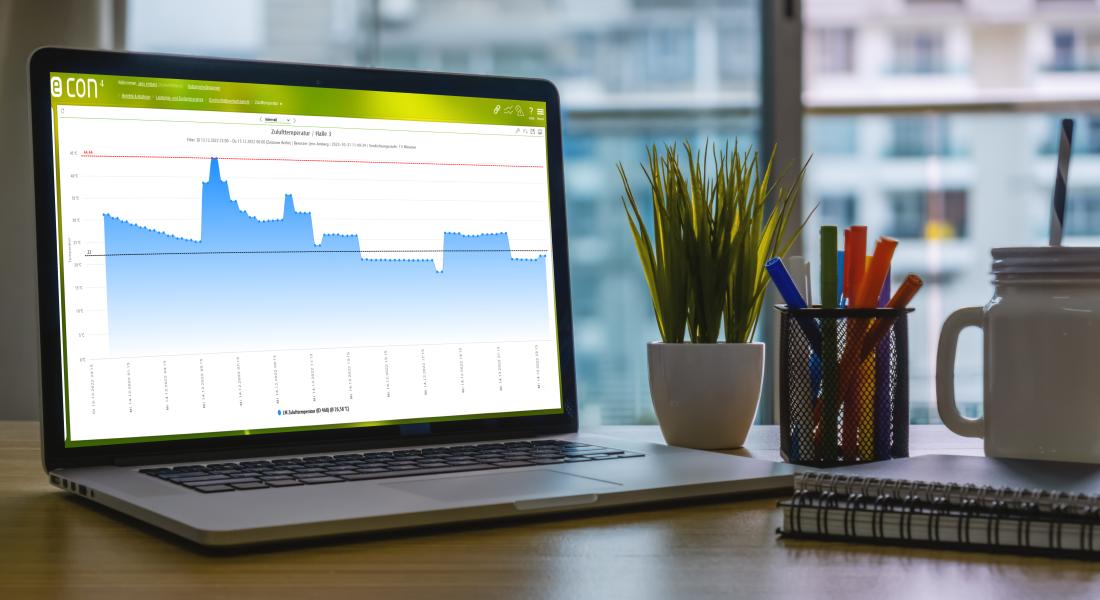The new waste heat register in accordance with the Energy Efficiency Act

The new Energy Efficiency Act (EnEfG) came into force on November 14, 2023. This law obliges companies with an average total energy consumption of more than 2.5 GWh per year to avoid waste heat and reduce it to a technically unavoidable level. Companies should consider both internal and external options for using waste heat.
What is a waste heat register?
A waste heat register is a system for recording and displaying sources of waste heat in a company. It is used to identify unused waste heat and collect the relevant data to enable its recovery and use.
Dealing with waste heat involves three main steps:
- Cadastral reporting: recording and documentation of waste heat sources in a register containing information on the location and quantity of waste heat sources.
- Recording of potential: Evaluation of the recorded waste heat sources with regard to their usability and the technical and economic possibilities.
- Monitoring: Continuous monitoring and analysis of waste heat use to optimize efficiency and comply with legal requirements.
From January 1, 2025, companies are obliged to record and document their waste heat potential and sources. This data must be reported annually to the Federal Office for Energy Efficiency, which has set up a special "Waste Heat Platform" for this purpose.
Platform for waste heat
The Waste Heat Platform is a central, public database that makes waste heat potential in Germany visible and promotes the exchange of information between heat producers and consumers. It was developed by the Federal Agency for Energy Efficiency (BfEE) at the Federal Office of Economics and Export Control (BAFA) and has been available online since April 15, 2024. Further information can be found in the BAFA press release.
A classification - Where does the requirement to reduce waste heat come from?
National targets under the Climate Protection Act
The German greenhouse gas reduction targets are set out in the Federal Climate Protection Act. These targets provide for emissions to be reduced by at least 65% by 2030 and by at least 88% by 2040 compared to 1990 levels. Germany is aiming for net greenhouse gas neutrality by 2045
These ambitious targets are a central component of national climate policy and are intended to help limit global warming and mitigate the effects of climate change. The implementation of these targets requires comprehensive measures in all sectors, including industry, transport and energy supply.
Heat consumption requirements for German industry
Industrial processes generate considerable amounts of surplus heat, which often remains unused and is released into the environment. This unused heat not only represents a waste of valuable energy, but also contributes to global warming.
The Fraunhofer IWU reports that, according to EU statistics, the German industrial sector consumed around 23 percent of Germany's final energy demand in 2021. Of this, process heat accounts for around 68% of total industrial energy consumption. Overall, the heat consumption of industry in Germany amounted to around 460 terawatt hours (TWh) in 2021. By using this waste heat, companies can optimize their energy consumption, reduce costs and make an important contribution to climate protection at the same time. The reduction of waste heat is therefore a central component of sustainable energy policy and a step towards a more climate-friendly industry.
Which companies have to report waste heat data?
Companies with an average annual total final energy consumption of more than 2.5 gigawatt hours (GWh) are obliged to provide information on waste heat. This obligation applies to large industrial companies as well as smaller companies, provided they exceed the above-mentioned consumption limit. The recording and reporting of waste heat data is a key component of the Energy Efficiency Act (EnEfG) and aims to promote the use of waste heat and increase energy efficiency.
Until December 31, 2024: Determination of waste heat potential (in accordance with Section 17 EnEfG)
Reportable waste heat potentials
All waste heat potentials that are generated as a by-product of industrial processes, power plants or other technical systems and are technically usable must be reported. Companies must record and document detailed information on the quantity, temperature profiles and possible uses of the waste heat. Minor thresholds below which no reporting is required must be observed.
Deadlines: The first report to the platform for waste heat has already been submitted by January 1, 2025. The data must now be updated annually and reported again. These deadlines must be adhered to in order to meet the legal requirements and avoid possible sanctions. The first update is due on March 31, 2026.
Fines: Compliance with the waste heat requirements is the responsibility of the federal states, while data reporting is the responsibility of BAFA. Violations are considered an administrative offense and can be punished with a fine of up to 100,000 euros.
From 2025: What should companies do now (in accordance with Section 16 EnEfG)?
The first step towards a comprehensive analysis of existing waste heat potential has been taken with the initial notification. The task now is to work out sensible potential uses.
Not only can this save money and CO2 emissions, but regulatory requirements also need to be considered: The Energy Efficiency Act provides for a general obligation to avoid and use waste heat, as long as technical feasibility and reasonableness are given.
We recommend that the next step is to draw up a waste heat avoidance and utilization concept:
- Data collection: recording existing waste heat sources and sinks as well as the plant technology, if necessary by means of an on-site inventory.
- Pinch analysis: Carry out a pinch analysis to identify efficiency potential.
- Development of measures: Development and documentation of technical and organizational measures to avoid and use waste heat.
- Profitability calculations: Preparation of profitability calculations to evaluate the proposed measures.
